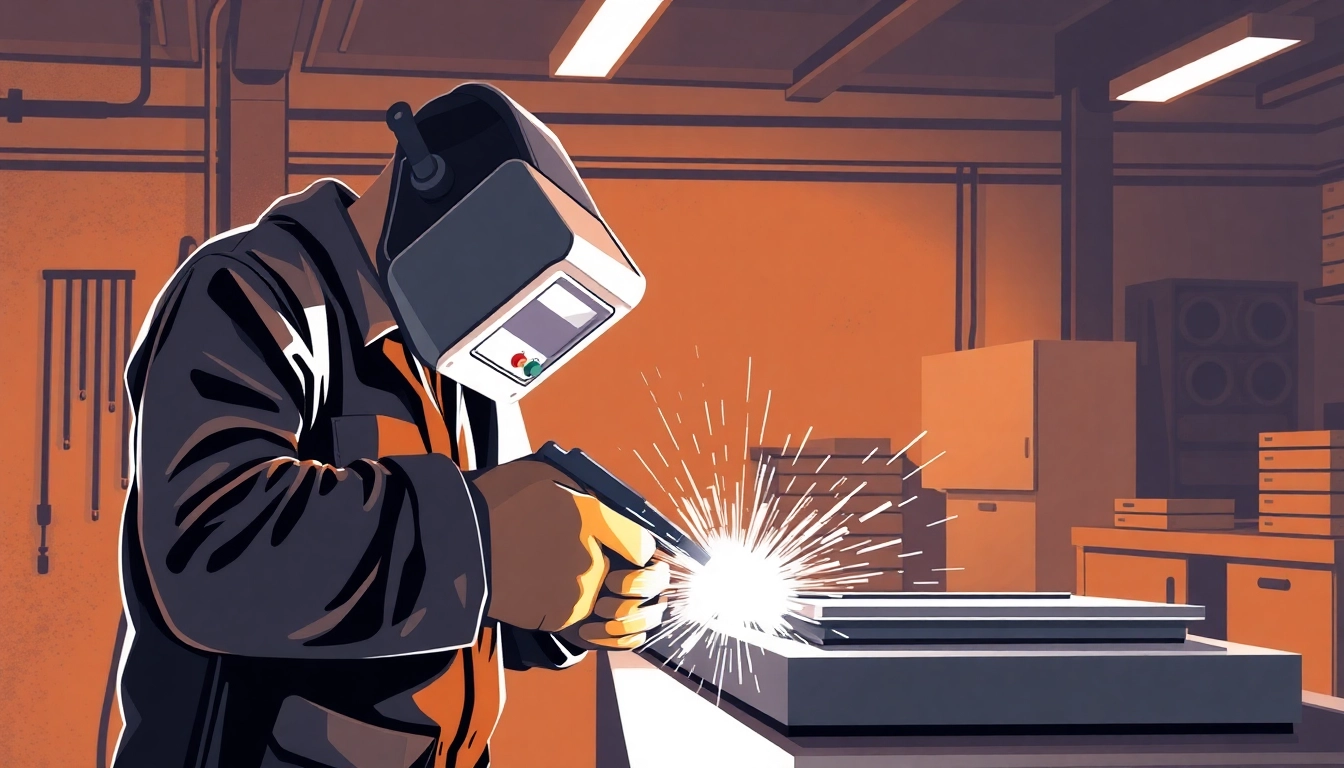Understanding AC DC TIG Welders
What is an AC DC TIG Welder?
An ac dc tig welder is a versatile welding machine designed to handle a variety of materials, notably aluminum and stainless steel. The key feature of this equipment is its ability to switch between alternating current (AC) and direct current (DC), which allows for enhanced control and flexibility during welding processes. AC is particularly useful when welding aluminum, as its cleaning cycle efficiently removes oxidation from the surface, promoting better weld quality. Conversely, DC is favored for welding metals like steel due to its steadier arc and deeper penetration capabilities. This duality makes AC DC TIG welders essential in industrial and fabrication settings where diverse materials and applications are common.
Benefits of AC DC TIG Welding
AC DC TIG welding offers numerous advantages that elevate its status in the welding community:
- Versatility: The ability to weld various materials effectively, from aluminum to stainless steel and even copper, makes AC DC TIG welders ideal for fabrication shops and DIY enthusiasts alike.
- Precise Control: TIG welding is recognized for its precision, which is crucial in applications requiring aesthetic appeal or structural integrity, such as automotive and aerospace welding.
- High-Quality Welds: The process produces cleaner and stronger welds with less spatter, leading to less post-weld cleanup and finishing work.
- Flexibility in Settings: Users can adjust the welder’s settings according to the material being welded and its thickness, allowing for a tailored approach to each welding task.
Key Features to Look For
When selecting an AC DC TIG welder, certain features can significantly impact the performance and usability of the machine:
- Wattage and Amperage: Higher amperage and wattage capacities allow for welding thicker materials and a wider range of welding applications.
- Pulse Control: This feature allows for better control of the heat input, making it easier to work with thin materials and reduce distortion.
- Foot Pedal Control: A foot pedal gives the welder hands-free control over the arc, providing greater flexibility and precision during welding.
- Duty Cycle: The higher the duty cycle, the longer the welder can operate without overheating. This is critical for professional environments where extended use is the norm.
How to Choose the Right AC DC TIG Welder
Assessing Your Welding Needs
Choosing the right AC DC TIG welder starts with a clear assessment of your welding needs. Consider the materials you’ll be working with, the thickness of the materials, and the type of projects you plan to undertake. If you’ll primarily be welding aluminum, a welder with robust AC capabilities is essential. Conversely, if steel is your main focus, ensure the welder can provide stable DC output. Perform a workload analysis to determine the power and performance requirements. Depending on whether you are a hobbyist or a professional, your requirements may differ greatly.
Considering Budget and Brands
Your budget plays a crucial role in selecting an AC DC TIG welder. Prices can vary significantly based on features, brand reputation, and expected duty cycle. Brands like Miller, Lincoln Electric, and Everlast are well-regarded in the industry but may come at a premium. Comparing different models within your price range can often yield features that maximize your investment. Additionally, consider warranty offerings and customer service reputation; these factors can save you expenses in potential repairs or replacements down the line.
Top Recommendations for all Skill Levels
For beginners, a welder like the Everlast PowerTIG 200DV offers user-friendly controls and a great balance of features at an accessible price. For intermediate users, the Miller Diversion 180 is a solid choice, providing excellent control and functionality. Advanced users may appreciate the Miller Dynasty 210, known for its efficiency, versatility, and compact design, suitable for professional and industrial applications. Each model varies in terms of specifications, so assessing them against your arsenal of tasks will guide you toward the right choice.
Setting Up Your AC DC TIG Welder
Essential Equipment and Accessories
Setting up your welder requires several essential pieces of equipment and accessories to ensure optimal performance:
- Gas Cylinder: Argon is the preferred shielding gas for TIG welding, and having an appropriately sized cylinder will ensure consistent supply.
- Tungsten Electrodes: Choosing the right electrode size and type (pure, thoriated, or ceriated) is vital for achieving the desired arc characteristics.
- Filler Rods: Ensure you select filler rods that match the materials being welded for optimal adhesion and strength.
- Personal Protective Equipment (PPE): Invest in quality welding gloves, helmets, and protective clothing to ensure safety during the welding process.
Achieving Optimal Settings for Different Materials
Each material requires specific settings on your AC DC TIG welder to achieve optimal results. Generally, harder metals like stainless steel can be welded using DC with a lower amperage, while aluminum often requires higher amperage and AC to clean the oxide layer effectively. It’s crucial to consult the manufacturer’s guideline for parameters such as voltage, travel speed, and amperage for different thicknesses and materials. Keeping a detailed log of settings used on various projects can help in fine-tuning your approach over time.
Safety Protocols and Best Practices
Safety should never be compromised in welding. Following standard precautions ensures that both the welder and those in the surrounding environment are protected. Key safety protocols include:
- Workspace Setup: Ensure the work area is clear of flammable materials and well-ventilated to mitigate fumes.
- Proper Posture: Maintaining good posture while welding reduces the risk of repetitive strain injuries.
- Utilizing PPE: Always wear appropriate PPE, including safety glasses or face shields, gloves, and flame-resistant clothing.
Advanced Techniques with AC DC TIG Welding
Welding Aluminum vs. Steel
While both aluminum and steel can be welded using an AC DC TIG welder, the techniques and settings differ significantly. Aluminum requires AC current to clean the oxide layer and ensure a strong bond, necessitating specific adjustments regarding frequency and balance. On the other hand, steel welding employs DC for its ability to penetrate more deeply into the material, providing a consistently strong weld. Understanding these differences allows welders to adjust their approach depending on the material at hand.
Using Pulse Settings for Better Control
Pulsing the arc allows welders to control heat input better, leading to increased precision, especially on thin materials. The pulse settings enable the welder to alternate between the peak output and a lower background output, helping to prevent warping and distortion. Mastering the use of this feature can significantly enhance the quality of your welds and the overall efficiency of the welding process.
Common Mistakes to Avoid
Even experienced welders can fall victim to common mistakes, which can compromise the quality of work and safety. Some of these include:
- Insufficient Cleaning: Not adequately cleaning the metal surface can lead to contamination and weak welds.
- Poor Arc Length Control: Maintaining a stable arc length is crucial; too short leads to burns, while too long results in overheating and weak welds.
- Ignoring Material Thickness: Failing to adjust settings for thicker or thinner materials can result in burn-through or inadequate fusion.
Maintenance and Troubleshooting of AC DC TIG Welders
Regular Maintenance Tips
Regular maintenance is essential for longevity and performance in any welding machine. Tips include:
- Regular Cleaning: Clean the welding torch and components regularly to prevent buildup of contaminants.
- Inspect Cables and Connections: Regularly check for wear or damage as frayed cables can lead to electric shock or operational failures.
- Replace Consumables: Regularly monitor and replace tungsten electrodes and filler rods to ensure optimal welding results.
Identifying Common Issues
Even the best machines can encounter issues. Common problems include:
- Inconsistent Arc: This may be due to improper cable connections or worn tungsten.
- Poor Weld Quality: Often linked to inadequate cleaning or incorrect settings for the materials being welded.
- Overheating: Usually caused by a duty cycle being exceeded or inadequate cooling.
When to Seek Professional Assistance
When troubleshooting your AC DC TIG welder, it’s vital to know when to seek professional help. If electrical issues arise, such as inconsistent power output or persistent overheating despite following maintenance practices, consulting a professional can save time and prevent damage. Additionally, if replacement parts are needed, sourcing them through qualified channels ensures that your welder continues to perform optimally and safely.




